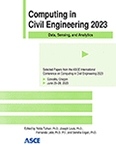Pilot Study of Powered Wearable Robot Use for Simulated Flooring Work
Publication: Computing in Civil Engineering 2023
ABSTRACT
Work-related musculoskeletal disorders pose a significant threat to the health, safety, and retention of skilled workers in the construction industry. Construction trades, such as floor layers, perform physically demanding work involving lifting materials and maintaining awkward postures, triggering low back disorders. Active back-support exoskeletons have emerged as potential preventive technology. This paper evaluates the suitability of a commercially available active back-support exoskeleton for a simulated flooring task by assessing measures such as range of motion, perceived level of exertion, and cognitive load. No significant difference was observed in the comparison of these measures with and without the active exoskeleton. However, the use of the exoskeleton triggered slight reductions in the range of motion of the back, perceived exertion, and mental demand. These preliminary findings could motivate more studies into the design and evaluation of similar technologies for improving construction workforce health and safety.
Get full access to this article
View all available purchase options and get full access to this chapter.
REFERENCES
Bequette, B., A. Norton, E. Jones, and L. Stirling. (2020). “Physical and cognitive load effects due to a powered lower-body exoskeleton.” Human factors 62(3): 411–423. https://doi.org/10.1177/0018720820907450.
BLS. (2017). “Injury and illness rate per 10,000 full-time workers.” Retrieved March 25, 2023, from https://data.bls.gov/pdq/SurveyOutputServlet.
Borg, G. (2004). “The Borg CR10 scale folder.” A method for measuring intensity of experience. Hasselby, Sweden: Borg Perception.
CDCP (Centers for Disease Prevention and Control). (2023). “Exoskeletons in Construction: Will they reduce or create hazards?” Retrieved March 25, 2023, from https://blogs.cdc.gov/niosh-science-blog/2017/06/15/exoskeletons-construction/.
Kermavnar, T., A. W. de Vries, M. P. de Looze, and L. W. O’Sullivan. (2021). “Effects of industrial back-support exoskeletons on body loading and user experience: an updated systematic review.” Ergonomics 64(6): 685–711. https://doi.org/10.1080/00140139.2020.1870162.
Kim, H. K., M. Hussain, J. Park, J. Lee, and J. W. Lee. (2021). “Analysis of Active Back-Support Exoskeleton During Manual Load-Lifting Tasks.” Journal of Medical and Biological Engineering. https://doi.org/10.1007/s40846-021-00644-w.
McGaha, J., K. Miller, A. Descatha, L. Welch, B. Buchholz, B. Evanoff, and A. M. Dale. (2014). “Exploring physical exposures and identifying high-risk work tasks within the floor layer trade.” Applied ergonomics 45(4): https://doi.org/857-864. 10.1016/j.apergo.2013.11.002.
Miura, K., H. Kadone, M. Koda, T. Abe, H. Endo, H. Murakami, M. Doita, H. Kumagai, K. Nagashima, and K. Fujii. (2018). “The hybrid assisted limb (HAL) for care support, a motion assisting robot providing exoskeletal lumbar support, can potentially reduce lumbar load in repetitive snow-shoveling movements.” Journal of Clinical Neuroscience 49: 83–86. https://doi.org/10.1016/j.jocn.2017.11.020.
Poliero, T., V. Fanti, M. Sposito, D. G. Caldwell, and C. Di Natali. (2022). Active and passive back-support exoskeletons: a comparison in static and dynamic tasks. 2022 9th IEEE RAS/EMBS International Conference for Biomedical Robotics and Biomechatronics (BioRob), IEEE. https://doi.org/10.1109/LRA.2022.3188439.
Poliero, T., M. Lazzaroni, S. Toxiri, C. Di Natali, D. G. Caldwell, and J. Ortiz. (2020). “Applicability of an active back-support exoskeleton to carrying activities.” Frontiers in Robotics and AI 7: 579963. https://doi.org/10.3389/frobt.2020.579963.
Tan, C. K., H. Kadone, K. Miura, T. Abe, M. Koda, M. Yamazaki, Y. Sankai, and K. Suzuki. (2019). “Muscle synergies during repetitive stoop lifting with a bioelectrically-controlled lumbar support exoskeleton.” Frontiers in Human Neuroscience 13: 142. https://doi.org/10.3389/fnhum.2019.00142.
Toxiri, S., M. B. Näf, M. Lazzaroni, J. Fernández, M. Sposito, T. Poliero, L. Monica, S. Anastasi, D. G. Caldwell, and J. Ortiz. (2019). “Back-support exoskeletons for occupational use: an overview of technological advances and trends.” IISE Transactions on Occupational Ergonomics and Human Factors 7(3-4): 237–249. https://doi.org/10.1080/24725838.2019.1626303.
Information & Authors
Information
Published In
History
Published online: Jan 25, 2024
ASCE Technical Topics:
- Automation and robotics
- Business management
- Construction engineering
- Construction industry
- Construction management
- Construction materials
- Continuum mechanics
- Design (by type)
- Dynamics (solid mechanics)
- Employment
- Engineering fundamentals
- Engineering materials (by type)
- Engineering mechanics
- Floors
- Labor
- Load factors
- Materials engineering
- Motion (dynamics)
- Occupational safety
- Personnel management
- Practice and Profession
- Public administration
- Public health and safety
- Safety
- Solid mechanics
- Structural design
- Structural engineering
- Structural systems
- Systems engineering
Authors
Metrics & Citations
Metrics
Citations
Download citation
If you have the appropriate software installed, you can download article citation data to the citation manager of your choice. Simply select your manager software from the list below and click Download.
